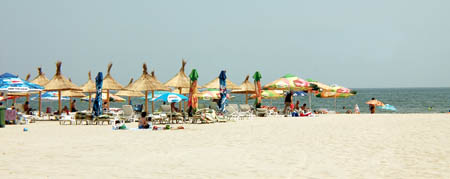The Seaside of Romania

The seaside of Romania is lined by beaches of unique atmosphere and plenty to see, such as Greek or Roman ruins, and there is always something more to discover. The Danube Estuary is a natural curiosity and is recommended not just for anglers.
Holidaymakers in Mamaia are welcomed by a beach covered with tiny white seashells and silver sea. Major rivers streaming into the Black Sea, such as the Danube, the Dnieper, the Dniester and the Don make the Black Sea not just silverfish grey but also less salty.
Hoteliers in Mamaia have been recently trying to upgrade their service to Western European standards, there are spa & wellness hotels, beach bars, aquapark with waterslides. A wide range of water sports are also available in the clean sea: windsurfing, jet-ski, water-ski are all at your disposal.
The variety of nightlife is guaranteed by a number of bars, restaurants, nightclubs and music bars of Mamaia, where everybody can find their style of music, be it funky, soul or techno. It is highly recommended to have cash in some local currency at hand from an official exchange office, as some institutions handle the lei /euro exchange rate quite flexibly.
The capital of the Romanian seaside, and the biggest port of Romania, Constanta is located south from Mamaia. Its ancient predecessor, Tomi was founded in the 6th century BC by Greek sailors and tradesmen from Miletus in Anatolia. After the Greek period, a Roman ownership followed, and the city as the centre of Dacia province, was flourishing in the 1st to 3rd centuries AD. It is a good idea to start discovering the city starting from the middle of the old town, by the statue of Ovid, the poet of Constanta.
Right behind the statue of Ovid is the Museum of Archaeology, displaying an impressive collection of ancient relics found in the neighbourhood. Next to it, probably the most beautiful attraction can be seen: a Roman mosaic from around the 5th century. The floor, decorated by special geometric and vegetable patterns, used to cover 2000 square metres, having been one of the largest mosaics of the Roman Empire. The surviving part today is just a 50m long and 16m wide strip, but it is still an astonishing sight in its small detail.
By a few minute walk from the main square, we can get to another interesting monument of the city, the Turkish mosque. From its 50m tower there is a panoramic views to the port and the rooftops of houses.
